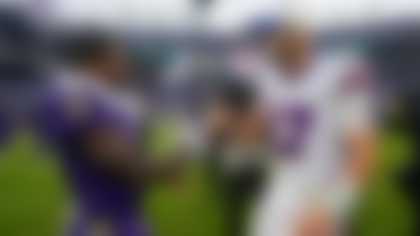In the hours after a settlement in the mammoth concussion lawsuit against the NFL was announced last week -- as retired players tried to figure out what it would mean for their care, as league executives exhaled at a significant threat removed -- a more long-term question emerged: What will football look like now that the lawsuit that catalyzed so much interest in player safety is over?
The answer will come quickly, as the regular season begins Thursday night with a major new rule that forbids players from initiating contact with the crown of the helmet outside of the tackle box. If the NFL wanted to settle now, to allow the new season to get out from underneath the considerable cloud the lawsuit cast on the league, then the rules in place seem to bow to reality: The concussion lawsuit might be gone, but concussions as an issue are not.
A rollback, even a subconscious one, to a less vigilant game -- when hits to the head and neck were not as scrupulously penalized -- is not likely in the offing this season or any other. Nor is a return to the "real" -- read: more injurious? -- football that fans and even some players occasionally clamor for. The lowered strike zone, the instructions to officials to err on the side of safety -- those are likely to be permanent reminders of the soon-to-disappear lawsuit.
"This is not going away," said Dean Blandino, the NFL's vice president of officiating. "The emphasis on these rules will continue. I just did training with our officials, and the message is, we are going to aggressively enforce these fouls. We're not backing off on the player safety part of it. That's the priority. We have to keep them safe."
Left unspoken: The NFL is the standard bearer for the game. A loosening in player safety rules enforcement now would inevitably trickle down to the college, high school and youth levels. The message has not reached everyone, though. In recent weeks, particularly after Dustin Keller's devastating knee injury, some players said they would rather take their chances with a hit to the head than one to the knee. That was an indication that the culture change the NFL has tried to manufacture in recent years, through a crash course in lowered strike zones and the tough love of penalties and fines, remains a work in progress. But during Monday interviews, even defensive players -- the ones most likely to incur a flag or fine -- did not, perhaps surprisingly, see the settlement as reason for the NFL to suddenly ease up on player safety.
New York Giants safety Antrel Rolle praised the crown-of-the-helmet rule, in part because he likes the message it sends: Keep your head up. And Rolle also zeroed in on another point -- many players already have altered their approach since the NFL first cracked down on hits to the head and neck during the 2010 season, so why turn back now?
"I think we've already seen a tremendous change in the way the game is played," Rolle said. "I don't think it's going to go backwards. Players have already adapted to that style of play. We're trying to be more cautious of our tackling angle points. I've adapted. I can't say I would never, ever hit someone in the head, but for the most part, my aiming points have definitely been lowered a little bit."
Since the spring, Blandino has met with players and coaches to discuss the rules. Running backs wanted to know what to do to avoid getting called for the crown-of-the-helmet penalty; defensive backs ask what constitutes pass interference. Blandino cautioned against overreacting to one play -- like the one that led to Keller's injury -- and said defensive players, particularly cornerbacks who are outweighed by tight ends, still need to have the ability to go low, to wrap up their opponents by the legs. Still, the competition committee will review injuries like Keller's to make sure there is not a trend, and then make a recommendation about whether the strike zone should be narrowed further.
They will also continue to look at the crown-of-the-helmet rule to see if it, too, should be refined. Blandino said that the competition committee will probably discuss whether to expand the new rule to include plays inside the tackle box, although there might not be much appetite for that, because it likely would prevent running backs from lowering their shoulders to absorb a blow while protecting the football.
A shrinking strike zone or a move to call a crown-of-the-helmet penalty in the traffic of the tackle box likely would ignite the ire of players who have begun to embrace protections for the head and neck. Blandino could not forecast what other major rules changes might be coming. Zak DeOssie, the Giants' long snapper and union representative, thinks that the proper balance has been struck.
The regular season begins this week, and while the lawsuit has ended, it is up to officials to make sure the changes it helped bring about stick.
"It's not going back to the old way," Giants linebacker Mathias Kiwanuka said. "It can still be a very exciting game with these new rules. It's a violent game and we've been playing it since we were little. You've been taught to hit a certain way. A lot of what they're calling 'defenseless players,' we think of as good football. But a lot of guys in my position are starting to feel maybe this is something we need to pay attention to."
Follow Judy Battista on Twitter @judybattista.












